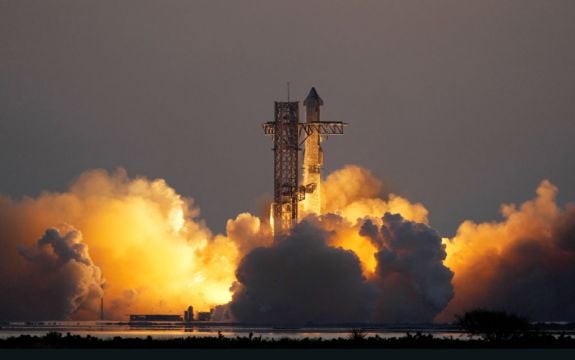SpaceX has launched its enormous Starship rocket on its boldest test flight yet, catching the returning booster back at the pad with mechanical arms.
Towering almost 400 feet, the empty Starship blasted off at sunrise from the southern tip of Texas near the Mexican border.
It arced over the Gulf of Mexico like the four Starships before it that ended up being destroyed, either soon after lift-off or while ditching into the sea.
The last one in June was the most successful yet, completing its flight without exploding.
This time, SpaceX founder and chief executive Elon Musk upped the challenge and risk.
The company brought the first-stage booster back to land at the pad from which it had soared seven minutes earlier. The launch tower sported monstrous metal arms, dubbed chopsticks, that caught the descending 232-ft booster.
“Are you kidding me?” SpaceX’s Dan Huot observed with excitement from near the launch site. “I am shaking right now.”
“This is a day for the engineering history books,” added SpaceX’s Kate Tice, from SpaceX headquarters in Hawthorne, California.
It was up to the flight director to decide, in real time with a manual control, whether to attempt the landing.
SpaceX said both the booster and launch tower had to be in a good, stable condition. Otherwise, it was going to end up in the gulf like the previous ones. Everything was judged to be ready for the catch.
Mechazilla has caught the Super Heavy booster! pic.twitter.com/6R5YatSVJX
— SpaceX (@SpaceX) October 13, 2024
Once free of the booster, the retro-looking stainless steel spacecraft on top continued around the world, targeting a controlled splashdown in the Indian Ocean.
The June flight came up short at the end after pieces came off. SpaceX upgraded the software and reworked the heat shield, improving the thermal tiles.
SpaceX has been recovering the first-stage boosters of its smaller Falcon 9 rockets for nine years, after delivering satellites and crews to orbit from Florida or California. But they land on floating ocean platforms or on concrete slabs several miles from their launch pads – not on them.
Recycling Falcon boosters has sped up the launch rate and saved SpaceX millions.
Mr Musk intends to do the same for Starship, the biggest and most powerful rocket ever built with 33 methane-fuel engines on the booster alone.
Nasa has ordered two Starships to land astronauts on the moon later this decade.
SpaceX intends to use Starship to send people and supplies to the moon and, eventually, Mars.







